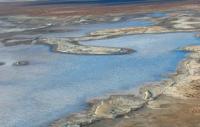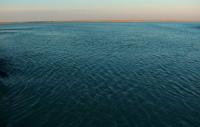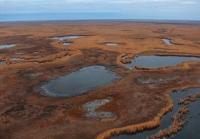You are here
Reasons for drying of Aral Sea.




Big and Small Aral Sea.
“To be strong, one must be like water. There are no obstacles - it flows; dam - it will stop; the dam will break - it will flow again; in a quadrangular vessel it is quadrangular; in a round - round. Because she is so compliant, she is most needed and stronger than anything.”
Lao Tzu.
Drive from Nukus to Beineu.
In terms of size, the Aral Sea stood in fourth place among the lakes of the world: after the Caspian, the Upper Lakes of North America and Lake Chad. The area of the Aral Sea was 64,490 sq km (with islands), the longest - 428 km, the largest width - 284 km.
In 1961, the modern period of sea life began, called the period of active anthropogenic influence on the regime. A sharp increase in irrevocable withdrawal of runoff, reaching in some years 70–75 km3 / year and natural low water levels in 1960 – 1980, led to the drying up of the sea and its division into two parts Big and Small Aral.
The following may be put forward as possible reasons for the drying of the Aral Sea:
The rapid development of agriculture in Central Asia, which entailed the abstraction of a large amount of water from the two main tributaries of the Aral Sea (Syr Darya and Amu Darya) for the needs of field irrigation.
It is possible that this is a natural process that is not connected or weakly connected with human economic activity. So, according to information from Medieval sources, the Aral Sea-lake dried up earlier, but then was restored.
Stages of drying the Aral Sea:
Decrease in water level from 1961 to 1990 by 15 meters (from 53 to 38 meters), the volume of water decreased by 3 times.
1989 - The United Aral Sea broke up into the Small and Big Aral.
2001 - The Great Aral fell into the western and eastern parts. Renaissance Island became a peninsula.
2005 - a dam was built to prevent the flow of water from the Small Aral Sea to the Big Aral. The beginning of the active drying of the Great Aral.
2009 - The Renaissance Peninsula became part of the land. The eastern part of the Big Aral has dried up. All parts of the Aral Sea have decreased in size.
2010 - in summer, the eastern part of the Big Aral Sea is filled with meltwater from the Amu Darya. The area of the Eastern and Northern Aral Sea, as well as Lake Tuschibas increased. The Western Aral has somewhat dried up.
2011 - Eastern and Northern Aral decreased in size, Tuschibas and Western Aral increased slightly.
2012 - the area of the South Aral Sea was changing with varying success: satellite images for May-June say that the Aral Sea is somewhat shallow compared to the previous year. At the same time, the image for August 13 indicates that the eastern part of the sea has significantly increased in size.
However, by October 9, a significant decrease in the area of the Great Aral Sea was noticeable. The area of the Small Aral Sea practically did not change.
After 2009, the drying up of the Great Aral Sea practically ceased, and in certain periods (summer 2010 and 2012), the sea even increased in size. This can be explained by a decrease in evaporation, which is directly proportional to the surface area of the water. Drying of the Small Aral Sea ceased in the early 1990s due to the construction of a number of hydraulic structures in the Berg Strait.
The consequences of the drying up of the Aral sea:
Destroyed almost all the inhabitants of the Aral Sea due to the strong increase in water salinity.
Climate change - a large aridity and continental climate in the Aral Sea.
Formation of the Aralkum desert.
The constant dust storms that carry both sand and pesticides from the bottom of the drying sea are an increase in disease in the region.
The Renaissance Island, on which biological weapons were tested in Soviet times, ceased to have a natural defense - the danger of dangerous bacteria entering the mainland.
$ 2 billion spent on saving the Aral Sea
The countries of the International Fund for Saving the Aral Sea (IFAS) allocated about two billion dollars for measures to stabilize the situation in the Aral Sea region.
Authority:
http://cyclowiki.org
Photo
Alexander Petrov.







